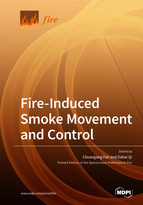Fire-Induced Smoke Movement and Control
A special issue of Fire (ISSN 2571-6255). This special issue belongs to the section "Fire Risk Assessment and Safety Management in Buildings and Urban Spaces".
Deadline for manuscript submissions: closed (15 January 2023) | Viewed by 31595
Special Issue Editors
Interests: fire; smoke and combustion
Interests: building mechanical systems; building energy; fire smoke control
Special Issues, Collections and Topics in MDPI journals
Special Issue Information
Dear Colleagues,
Fire-induced smoke influences the safe evacuation of occupants and firefighters’ ability to extinguish a fire. About 80% of deaths in fires were caused by the toxic smoke, according to statistics. Hence, how to control smoke is of great importance, in order to reduce fire hazards.
In this Special Issue proposed for the journal Fire, which is indexed in Science Citation Index and Scopus, we seek articles associated with fire-induced smoke movement and control in both unconfined and confined environments, including high-rise buildings, tunnels, subways, mines, atriums, street canyons, etc.
In this Special Issue, the scope is to gather original, fundamental and applied research concerning experimental, theoretical, computational and case studies that contribute towards the understanding of fire-induced smoke. Original research articles and reviews are welcome. Research areas may include (but are not limited to) the following:
- Fire-induced smoke production;
- Smoke movement;
- Smoke control by ventilation or water mist;
- Smoke stratification in confined spaces;
- Smoke extraction by mechanical ventilation or natural ventilation;
- Modeling and simulation of smoke.
We look forward to receiving your contributions.
Prof. Dr. Chuangang Fan
Prof. Dr. Dahai Qi
Guest Editors
Manuscript Submission Information
Manuscripts should be submitted online at www.mdpi.com by registering and logging in to this website. Once you are registered, click here to go to the submission form. Manuscripts can be submitted until the deadline. All submissions that pass pre-check are peer-reviewed. Accepted papers will be published continuously in the journal (as soon as accepted) and will be listed together on the special issue website. Research articles, review articles as well as short communications are invited. For planned papers, a title and short abstract (about 100 words) can be sent to the Editorial Office for announcement on this website.
Submitted manuscripts should not have been published previously, nor be under consideration for publication elsewhere (except conference proceedings papers). All manuscripts are thoroughly refereed through a single-blind peer-review process. A guide for authors and other relevant information for submission of manuscripts is available on the Instructions for Authors page. Fire is an international peer-reviewed open access monthly journal published by MDPI.
Please visit the Instructions for Authors page before submitting a manuscript. The Article Processing Charge (APC) for publication in this open access journal is 2400 CHF (Swiss Francs). Submitted papers should be well formatted and use good English. Authors may use MDPI's English editing service prior to publication or during author revisions.
Keywords
- smoke production
- smoke movement
- smoke control
- smoke stratification
- smoke extraction







